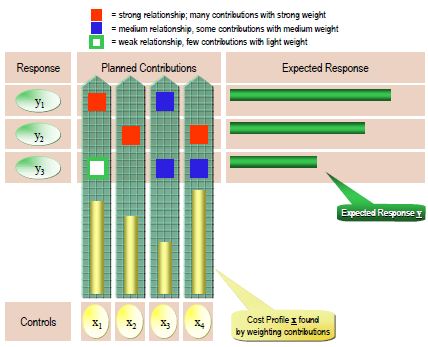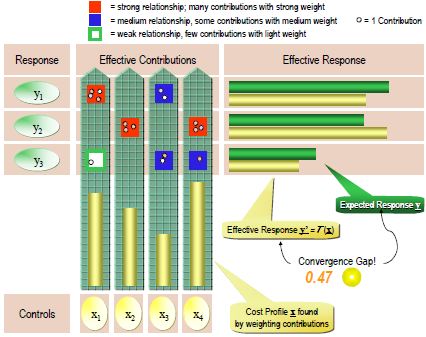Do We Need a Matrix for QFD?
January 21st, 2011 by Dr. Thomas M. Fehlmann
Bridging the Communication Gap – It’s a Matrix!
Most probably, engineers have different view than marketers, or top management, and the real difficulty is not only finding the solution but communicating it to the various stakeholders. This is soft, fuzzy data as well.
As a simple example, take a customer help desk organization. They want to become brilliant and meet the expected customer’s needs profile (the y) in aspects such as friendliness, response time, and accuracy of the response. As controls for the process (the x), we might have training of the help desk employees, performance of the IT equipment, salary system, and work environment. Now, if the upper management wants to invest into its help desk operations, the question is how much to spend per control times response cell. Note that items in matrix cells need communication and cost effort.
The cells of the matrix contain the work items, as for instance

| Responses: | |
| y1: Friendliness | |
| y2: Response time | y3: Accuracy |

| Controls: | |
| x1: Training | x2: IT performance |
| x3: Salary & bonus | x4: Work environment |
Summing up the columns of the matrix, weighted by customer’s needs, the Financial Manager can calculate how much of the available budget he should assign to which control function (the x). This is actually the dual space to the original transfer function, and the original meaning of (Quality) Function Deployment in Japan.
On the other hand, the transfer function maps controls to response, thus summing up the impacts per row, weighted by the investment money spent (i.e., the control profile), and yields the total effective impact on the customer’s needs (the y’), i.e., the total money spent on meeting customer’s need. The response profile describes the effectiveness of the investment made; result of the transfer function.
The difference between the expected profile y and the effective profile y’ is called the Convergence Gap. In the sample matrix Fig. 2 it can be seen that too much effort is spent in either cell
Calculating the convergence gap is highly simple and can be accomplished by means of a spreadsheet. Communicating the QFD matrix to people and stakeholders is straightforward: strong relationship means active work is needed – it corresponds to explaining issues, providing training, set rules, or ordering tools for improving process performance. Management can set up their communication plans based on the QFD matrix. AHP or a Blitz QFD does not provide such information and support, neither for doing financial investments into processes, nor when managing stakeholder communication. Management must communicate why they invest here and not there. The QFD Matrix communicates with teams and stakeholders; AHP or Blitz alone does not.
About the Author

This article was published with permission from the German QFD Institute (QFD Institut Deutschland e. V., QFD-ID).
The author, Dr. Thomas Fehlmann, Dr. Math ETH, is one of the board members of the QFD Institut Deutschland e. V., QFD-ID, and QFD Architect & Six Sigma Master Black Belt.
Meet the QFD Architects and Master Black Belts
In Stuttgart, September 21 – 23, 2011, the world champions in QFD, wearing black and red belts, will meet and struggle together to discuss these and many more questions, relevant to global economy and to the wealth of people. We’ll meet the experts from Japan, Germany, US, Mexico, Brazil, Iran, and many more countries.
For more information about the venue, program, and call for papers please visit the conference homepage.
Pages: 1 2
This entry was posted on Friday, January 21st, 2011 at 5:00 pm and is filed under House of Quality, Advice, DFSS, Lean Six Sigma, Quality Function Deployment, QFD. You can follow any responses to this entry through the RSS 2.0 feed. You can also leave a response.



October 23rd, 2011 at 5:53 pm
We Need a Matrix for QFD
December 6th, 2011 at 8:20 am
i need for my colllege work
June 22nd, 2012 at 3:05 pm
Me gustaria saber mas de las matrices del QFD
March 16th, 2013 at 7:00 pm
Good night,
I’m Student of industrial engineer in Bogota, Colombia and I´m doing my degree work about QFD and its application in service companies and i need know if you have an archive in excel format for develop the struture of the QFD’s matrix. I hope your answer. Thanks.
October 7th, 2013 at 11:43 am
We Need a Matrix for QFD, I am studying.
September 16th, 2015 at 1:51 pm
For my work
October 8th, 2015 at 3:19 pm
i need a matrix of QFD because i am studyng
January 19th, 2016 at 2:23 pm
Hi, I’m studying Quality and productivity. Please your help,I need a Matrix in order to practice and solve problems, exercises
Thanks and regards,
PD
March 28th, 2016 at 6:59 pm
Please can you help me, I need a QFD template for present an activity .
Thanks in advance
Best regards
Ricardo Diaz